

Star Trek fans knew they would lose the planet Vulcan someday in a fiery implosion at the hands of the Romulans—but they probably didn’t expect it to lose the planet in real life, too. Now reality is once again following fiction: The exoplanet once considered to be the real Vulcan has been erased, based on a new analysis of old data.
The 2018 discovery of the exoplanet known as 40 Eri b, which is located around the real-life star canonically orbited by Spock’s fictional homeworld, has turned out to be a false alarm. In a new research paper accepted for publication in the Astronomical Journal, astronomers used years of observations to re-analyze many previous exoplanet detections, including that of 40 Eri b. Unfortunately, astronomers hadn’t actually found Vulcan after all.
“As we continue to study objects with better and more precise instruments, reevaluating things we thought we already knew can lead to new conclusions about what’s really going on,” says Ohio State University astronomer Katherine Laliotis, lead author on the new work. In the case of 40 Eri b, the signal previously thought to be a planet turned out to be activity on the star’s surface. This work, she adds, is “a reminder that re-studying and reproducing already published results is a very valuable use of time.”
40 Eri b was originally detected using the radial velocity method, in which astronomers analyze the different wavelengths of light coming from a star. As a planet orbits a star, it’ll tug on its sun ever so slightly. When this tug pushes the star away from Earth, the star appears redder—thanks to the Doppler effect—and if it moves toward us, it appears bluer. With this method, astronomers believed they found 40 Eri b: A Neptune-sized planet 16 light-years away, so close to its star that a year would last only 42 days. This wouldn’t have been a particularly pleasant or habitable planet, but it made waves thanks to its sci-fi ties.
[Related: Newly discovered exoplanet may be a ‘Super Earth’ covered in water]
Some astronomers, such as NASA astronomer Eric Mamajek, immediately expressed doubts about the supposed detection. That’s because the time it took for this planet to complete one orbit was suspiciously close to the time the star takes to rotate. His suspicions were right. By tracing a feature of the light spectrum known to be part of the star, Laliotis and collaborators confirmed the star’s rotation rate, marking the end of the possible planet 40 Eri b.
They didn’t specifically set out on a mission to kill Vulcan, though. This work was part of a bigger analysis, looking into all of NASA’s top picks for future exoplanet exploration—and 40 Eridani just happened to be on the list. Astronomers are always collecting new data, observing different stars, but “many planetary systems haven’t been officially updated since they were published in the early 2000s,” according to Laliotis.
Astronomers are already starting preparation for the next big space telescope, known as the Habitable Worlds Observatory. This future NASA mission aims to take photos of Earth-like planets around sun-like stars, allowing scientists to directly look into these exoplanets’ atmospheres for oxygen and other signs of life. Laliotis’s work fits right into this plan—she says this study aimed to figure out “what [planetary] systems we already understand well, what systems we have a misunderstanding of, and what systems need to be observed a lot more in the coming years.” This review will help make sure the future telescope’s precious observing time is used wisely.
“NASA is planning to spend billions of dollars on future missions to fly telescopes to study planets,” says Jessie Christiansen, project scientist at NASA’s Exoplanet Archive. “Imagine if this had been one of the targets! It’s not real!”
Although astronomers are, of course, glad to see rigorous scientific work being done, they’ll also admit that they are a bit sad about losing an exoplanet with such a cool sci-fi crossover. “I’m sad whenever any planet gets disproven, but this one hit especially hard because I’ve been using it for a few years now as a provocative, intriguing tie between the real worlds we’re discovering and the fictional worlds we know and love,” says Christiansen, who also started a lively Twitter conversation on the topic.
This doesn’t completely rule out a real-world equivalent of Vulcan, though. The Neptune-sized planet discovered in 2018 isn’t there, but it’s possible a smaller planet—one we haven’t seen yet—still exists around the star 40 Eridani. With current technology and observations, astronomers simply can’t detect any planet smaller than 12 times Earth’s mass on an orbit similar to Earth’s. “This means there’s still a chance that Vulcan exists. In fact, there’s even a chance that Vulcan could be in the habitable zone for the star,” says Laliotis.
Even if Vulcan is gone for now, Trekkie astronomers will still find ways to have fun with sci-fi and outer space. “There are still many other planets in the Star Trek universe that haven’t been disproven,” adds Louisiana State University astronomer Alison Crisp. One potential planet orbiting Wolf 359, for example, could still exist—the site of a major Star Trek battle.
UCLA astronomer Isabella Trierweiler actually sees a way this saga fits into Star Trek canon. “Until 2063, Vulcans are just observing Earth and waiting for us to develop warp capabilities,” Trierweiler says. “Maybe they were able to adjust our observations to hide the planet, maybe they found super strong cloaking devices, or maybe Vulcan was briefly one of those planets that phases in and out of dimensions!” Whatever Vulcan’s fate, humanity has a few more years of technological development ahead of us until we reach these sci-fi dreams. And perhaps those lofty goals will help us find a real planet around 40 Eridani.
